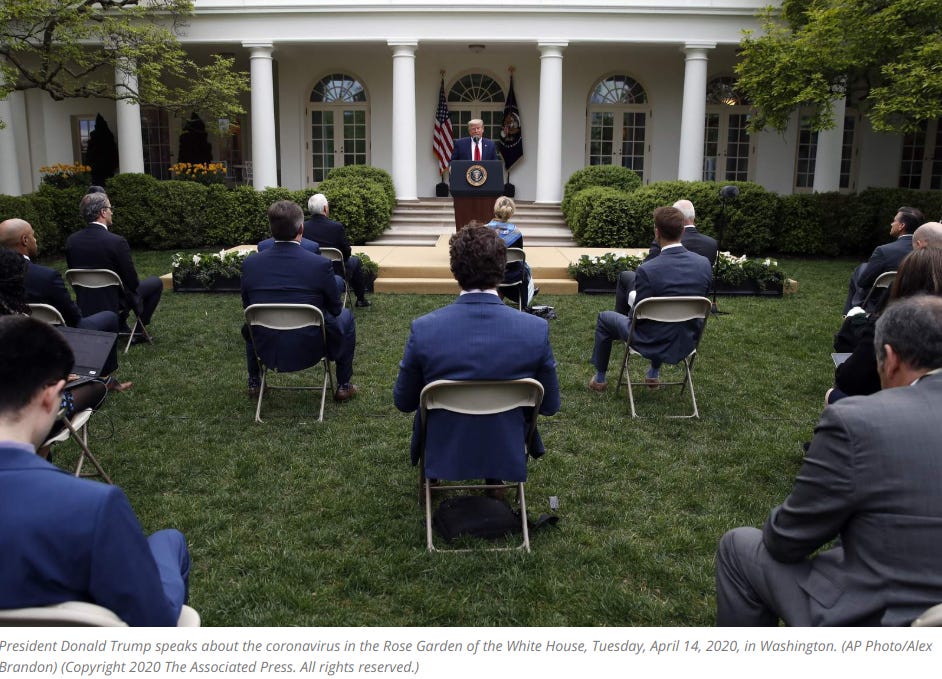Trump flips the agenda-setting script
In February 2016, the then-CBS head honcho Les Moonves said about the then-presidential candidate Donald Trump’s campaign, “It may not be good for America, but it’s damn good for CBS.”
It’s a quote I think about often. And not just for the media business.
The coronavirus has, incidentally, created a perfect opportunity for President Trump to hold campaign rallies from the White House and air them on national TV, while at the same time, flip a well-worn media theory script. One of my favorites, actually: Agenda Setting Theory.
Each day, the president takes to his bully pulpit (a term coined by President Theodore “Teddy” Roosevelt in 1904 to explain the power of the White House to push an agenda) on the White House lawn (a visual reminder that The People’s House is right behind him as journalists socially distance themselves) to ... well, I’m not so sure.
He stands behind the presidential seal and does the exact opposite thing Americans need to hear. Instead of acting as a calming agent (think of President Obama during the 2008 financial collapse; or even President Bush immediately after 9/11), Trump lashes out at enemies, real or imagined.

(Photo credit: Alex Brandon for The Associated Press)
Which then causes the media outlets to cover his “performance.” Indeed, ABC News’ chief Washington correspondent has a book out called “The Trump Show.” Neil Postman is laughing in his grave.
In the early 1970s, a couple of communications researchers looked into the effects of how news organizations frame political stories. They found that the media may not tell you how to think, but instead, what to think about, calling it "Agenda Setting Theory." In their abstract, the wrote:
"In choosing and displaying news, editors, newsroom staff, and broadcasters play an important part in shaping political reality. Readers learn not only about a given issue, but also how much importance to attach to that issue from the amount of information in a news story and its position. In reflecting what candidates are saying during a campaign, the mass media may well determine the important issues—that is, the media may set the “agenda”of the campaign."
Trump has flipped this upside down. Instead of the media being the sole entity attaching importance to an issue, the president has figured out that by using the free air time he gets, he can, in the words of the Washington Post, play “the media like a puppet while deeply damaging the public’s trust in the press as a democratic institution.”
This week, the New York Times, which has been at the center of media critics’ ire over fawning coverage, dug into the 260,000 (giver or take a few) words that the president has said during his weeks-long coronavirus updates. It found that, as many casual observers over the last several years have understood, Trump is solely about Trump. Which, when you think about it, is not typically a defining characteristic of the president of the United States.
“The self-regard, the credit-taking, the audacious rewriting of recent history to cast himself as the hero of the pandemic rather than the president who was slow to respond: Such have been the defining features of Mr. Trump’s use of the bully pulpit during the coronavirus outbreak.”
But the media’s torpor may be stirring, at least slowly. In addition to the Washington Post’s piece, take this piece in today’s New York Magazine, for example:
But it wasn’t until last Thursday, when he falsely suggested the virus could be treated by injecting disinfectants, that the partisan divide in the country seemed to bridge on at least this one subject: Trump shouldn’t be briefing. Or, if he is briefing, it shouldn’t be carried live by television networks.
As long as the media treats every fart and burp from the president as news, they will cover him. The point of view, that the media is a detached institution reporting what notable say and do, is an antiquated one that has been dismantled over the last 15 years, as the rise of technology and platforms allow anyone with a keyboard and internet connection to write whatever they want (HELLO NEWSLETTERS!!).
But what has happened is perhaps unsurprising: more people are tuning in. The alchemy of people self-isolating and wanting to know as much information as possible has been a recipe for viewership. Variety reported yesterday:
Viewership for all three of the nation’s main cable-news outlets soared in April as viewers tuned in at all hours for information on the spread of the coronavirus pandemic.
As more eyeballs tune in, let’s see what happens to ad rates.
Waiting for the time when I can finally say
That this has all been wonderful but now I'm on my way
Thank you for signing up and thank you for reading! This is the third issue of the Media Nut, and it’s astonishing that there are 481 subscribers already. As you can see, topics range from media business stories, to ad agency stories, to media theory. If you have any thoughts, please let me know! Or if you have any pitches, those’ll work, too.

